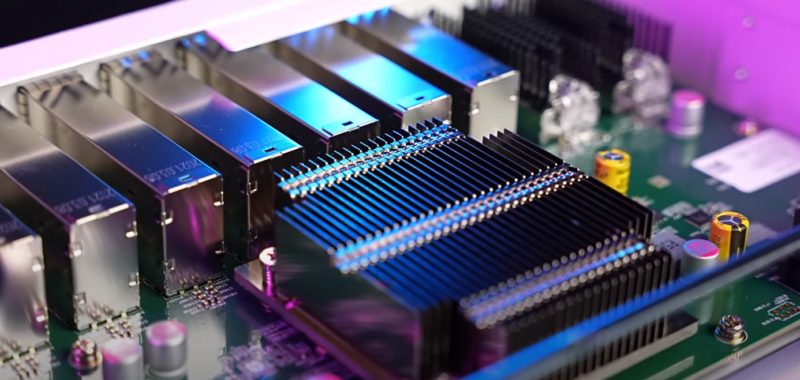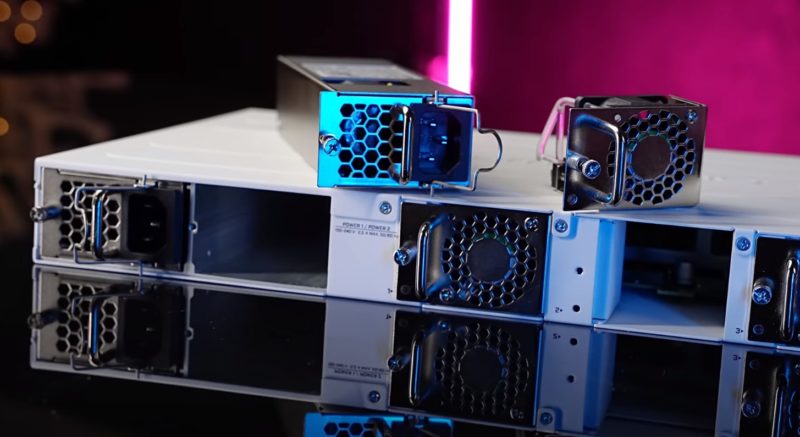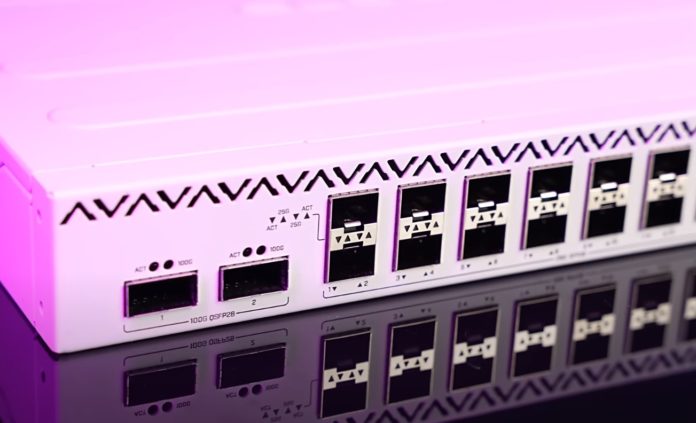MikroTik has a new 25GbE/ 100GbE switch. The MikroTik CRS518-16XS-2XQ-RM is the company’s new higher-performance switch designed to move up-market from the company’s 10GbE lines to something more modern. In the data center, 10GbE port shipments have been rapidly dropping, so it is important that the company gets to 25GbE soon.
MikroTik CRS518-16XS-2XQ-RM Switch Launched
The unit itself is a 1U switch. It is also, in many ways, a stablemate to the MikroTik CRS504-4XQ-IN. Instead of four 100GbE ports, we get two 100GbE QSFP28 ports and 16x 25GbE SFP28 ports. Since it is a MikroTik switch, it is also rack-mountable in a 1U form factor.

Powering the switch is the Marvell Prestera Aldrin2 switch chip. MikroTik is using a higher-quality switch chip than Ubiquiti’s 25/100GbE line. Ubiquiti is using a 4th-tier switch chip by sticking with Nephos, a company with a tiny market share. Marvell is a much larger vendor and has a larger customer base. The larger customer base generally drives quality. Still, Broadcom is the heavyweight in the 25/100GbE switch space.

The rear of the unit has two power supplies and four fan modules.

These PSUs and fan modules are hot-swappable and redundant. MikroTik is trying to move up market.

Hopefully, we can get one of these. We are also hoping the MikroTik CRS504-4XQ-IN we have had on order arrives at some point.
Final Words
MikroTik is moving up-market into 25GbE and 100GbE. Hopefully, 2.5GbE is not far behind. It will be nice to have a low-cost vendor in this space using decent switch chips. Also, these should use much less power than some of the more expensive 25GbE and 100GbE switches we have already reviewed so that will help bring this level of performance into lab environments.
Update: We now have our MikroTik CRS518-16XS-2XQ-RM Review live and an accompanying video:





Impressive stuff from Mikrotik, I really want ROS7 to become feature complete and stable enough to use it in production gear. That’s the missing piece.
@Carlos, just FYI, I have a CRS328-24P-4S+, and it was very unstable after upgrading from RouterOS 6.x to 7, but when I upgraded the firmware to the 7.x version by going to System – RouterBOARD – Upgrade, it became very reliable and stable. Just FYI to anyone who upgraded to 7 but didn’t also upgrade their firmware.
Given that a lot of 100G ports can be split into 4x 25G ports (and that is probably what has been done here to provide the 25G ports), any idea whether the reverse is true? Could you use one of those breakout cables in reverse to combine each set of four ports into a single 100G connection (i.e. without using bonding so you get an actual single 100G link)?
@Malvineous I’ve heard this ask before, but couldn’t ever find a proper use case. Without bonding, you’re going to need a NIC capable of negotiating with the switch at L1 level to bond the multiple links. If you’re already getting a NIC that can negotiate with the switch, then why do you even need to do multiple, bonded connections? Even 100G is possible on a single MMF LC fiber using BiDi transceivers over OM3 if your distances are less than 75m.
The only use case I can think of is that for some reason you have 25Gb NICs you are unwilling to replace in your servers, somehow have 4 ports, and don’t want to connect them to the primary 25G ports.
If there’s another use case, I’d be curious to hear it, but in most reverse scenarios, I think we have optics now that account for nearly every use case.
@Malvineous i think – yes. If switch chip configuration allows it, then there would be no problems with that. But question is, does it ? And does SW allow it.
@Cody Weaver – i guess he wants to convert this switch to 6 port 100G qsfp28 switch.
Of course, you couldn’t use any random four ports, only specific group of 4 adjacent ports.
Q in QSFP means “four”, as there are 4 parallel tx/rx channels, while SFP has only one. QSFP literally is for SFP ports in a single connector.
One thing I wasn’t sure about is if the SFP28s will negotiate down to 10G for legacy applications. The SFP28 NICs I have do that, but I imagine there’s some requirement for it to be intentionally implemented.
I am running CRS312, CRS309 and CRS305. All on ROSv7.3 stable. No stability problems. If you are migrating from old settings, just wipe all, reset, reconfigure from scratch, reboot. Just do it over CLI, all done in minutes.
@Bob H
Yes, it will. From the product brochure: “The 25-gigabit ports are backward compatible with 10 Gigabit and 1 Gigabit SFP devices. Mix and match as you need!”
In general on most devices, a SFP28 port will be capable of running at 10Gbase-X as well. Think of SFP28 as being SFP+ but with higher clock rates capability.
Ultimately this also boils down to firmware and transceivers supporting this. E.g. Some 10GBase-SR transceivers could only run at 10GbE but others could support 1GBase-SX as well.
Also, on some switches, they could not run 1GBase-X on SFP28 ports due to firmware limits but this is typically on switches designed for DC ToR or aggregation.
In some cases, this proves to be a major annoyance when you need to add a small amount of client devices running 1GbE and end up effectively needing another (set of) switch(es) just to cater for this.
Most notably, I’ve had to design and implement perimeter/ DMZ networks for AREN and supercomputers with varying WAN link types (mostly 100G, some 10G, and a very select few 1Gbase-T hand-offs) and had to have different border-leaf/ WAN switches just to cater the 1Gbase-T hand-offs.
@Dreamslacker
Thanks!
Are those QSFP28 also backwards compatible with 40gbe?